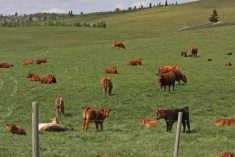AYLMER, Ont. – For close to five decades, 40 years of those owning his own farm, Alvin Lindsay has been a proud and usually prosperous tobacco producer.
“It has been a good business for me, a good living,” says the 69-year-old who now farms with his son Carl. “It kind of gets in your blood. It’s been a good life.”
These days, the second-generation farmer whose father was one of the first tobacco farmers in this south-central area of Ontario in the 1930s, speaks mainly in the past tense.
Read Also

Know what costs are involved in keeping crops in the bin
When you’re looking at full bins and rising calf prices, the human reflex is to hold on and hope for more. That’s not a plan. It’s a bet. Storage has a price tag.
He sees the imminent end of the industry that has generated billions of dollars of farm income in the region and multiples of that in community development.
Now, Lindsay is one of the many tobacco farmers who simply want out through a government exit package.
His once vibrant industry has been reduced to a shadow of what it was.
For 40 years, March meant growing seeds in his greenhouse for later planting of seedlings in the light sandy soil. This year, March is passing and his greenhouse remains empty as the industry waits to hear if there will be government help to exit.
It is uncertain how many acres he will seed on the traditional May long weekend start to the planting season.
In its March 19 budget, the federal government was silent on industry demands for help but the lobby continues.
“I’m really not very confident at all there will be a crop next year,” Lindsay said.
“I expect we’ll have limited acreage this year and next year. I just don’t know what there will be, if anything. I really think the industry is beyond repair. I don’t see an option to a buyout and an exit.”
It has not always been so.
Through many years in the 1960s, 1970s, 1980s and even into the 1990s, tobacco was one of the most lucrative crops in Ontario and a mainstay of the farm and rural economy of the Norfolk and Elgin county area southwest of Hamilton.
It was a crop that turned marginal sandy land susceptible to erosion into a farm income gold mine.
“We had some very good years, some stable years,” Lindsay said. “But then the trouble started.”
The trouble included anti-smoking government health policies, increasingly high tobacco taxes that produced a flourishing smuggling industry, followed by in the mid-1990s a brief retreat in taxation and a decline in smuggling.
Beginning in the late 1990s, taxes rose again and smuggling followed, in addition to legal cheap foreign imports by cigarette manufacturers that sharply eroded the domestic market and farm incomes.
These days, Lindsay is able to produce just 10 to 15 percent of the production allowed by the quotas he holds. On his farm and in the surrounding countryside, the capital and labour intensive operations are languishing.
To add insult to injury, several years ago manufacturers and governments forced farmers who wanted to stay in the business to invest tens of thousands of dollars in new indirect heat drying systems. The debt from that investment hangs over the industry.
Over the years, there were several government buyout programs and Lindsay resisted them all.
“I saw this as a good industry and believed if some left as the market declined, it would be a more stable future for the rest of us who stayed. But the last two years have definitely been the worst and I don’t really see any option now than a total exit.”
Of course, he said, it should be a staged exit over a number of years because a mass exit would make the assets worthless.
Industry leaders estimate average tobacco farm debt at $400,000 and assets that include kilns, heaters and harvesting equipment are not transferable.
Even if farmers find alternate crops for their fragile land, a mass movement of tens of thousands of acres into vegetables, fruits or other crops could cause havoc in those industries.
“Other sectors certainly are wary of that.”
Like other tobacco farmers, Lindsay accepts that society, governments and health advocates have won the battle against tobacco.
Still, he can’t help but complain about the government war on tobacco that made tax collectors “more addicted to tobacco than anyone.” They in turn used some of the tax revenue to fund anti-smoking lobby groups.
“It was frustrating,” he said.
But despite growing anti-smoking sentiment in society, Lindsay did not feel ostracized. Local communities and residents who benefited from a healthy tobacco producing sector were supportive.
“We were good for them, they were good to us.”
Still, after a lifetime in the industry, he is prepared to concede that the party is over.
Given the health issues around the product, an interviewer has to ask this healthy farmer the obvious question: are you a smoker?
Lindsay laughs. “I used to a bit but I haven’t for years. I chew. That’s how I satisfy my addiction.”














